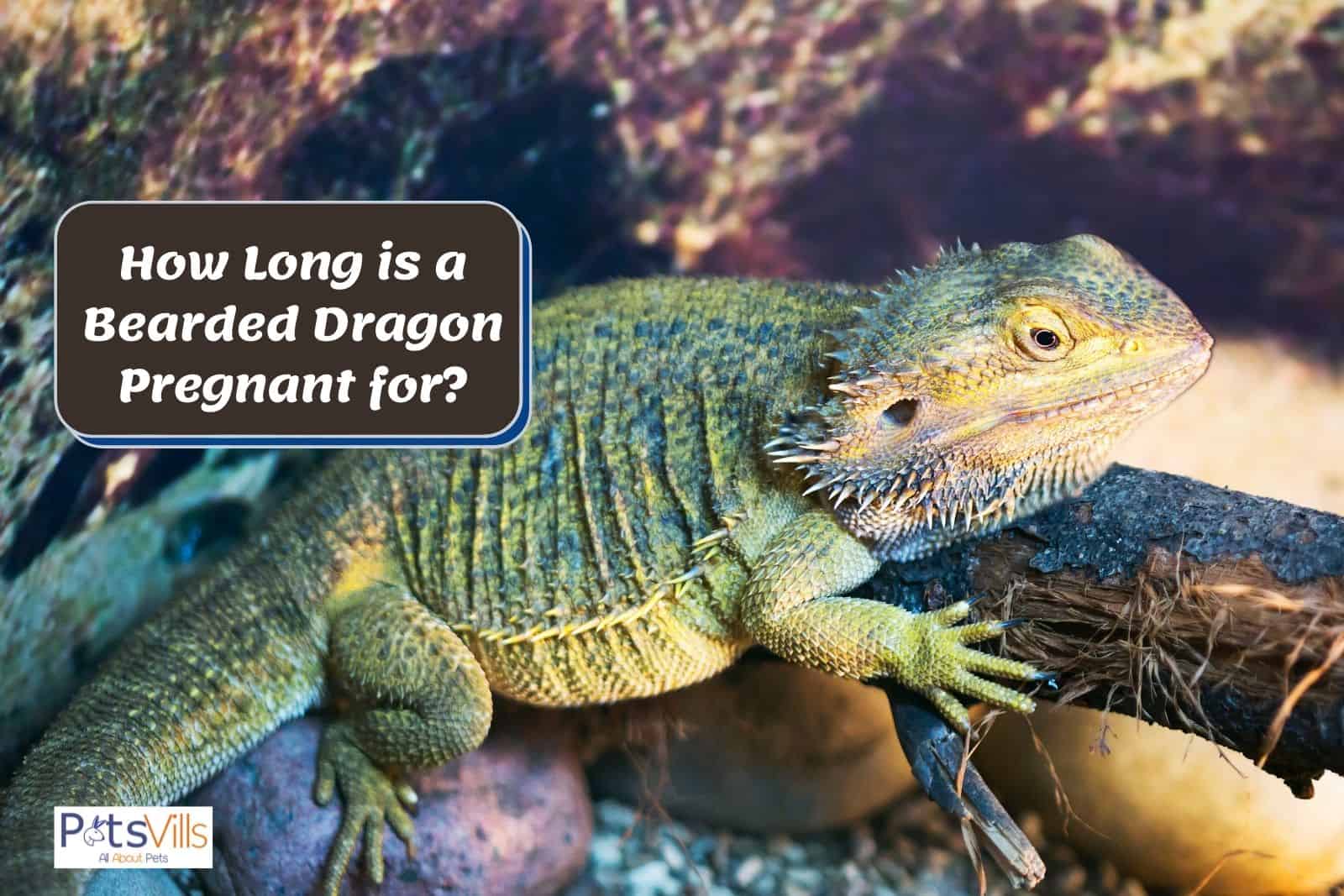How long is a bearded dragon pregnant for?
How do you know your beardie is pregnant?
And what do you do with a pregnant dragon?
Please keep reading to get the answer to these questions and facts about bearded dragon. Learn more about a female dragon’s pregnancy.
Check: Best Incubator for Bearded Dragons
Table of Contents
How Do Bearded Dragons Get Pregnant?
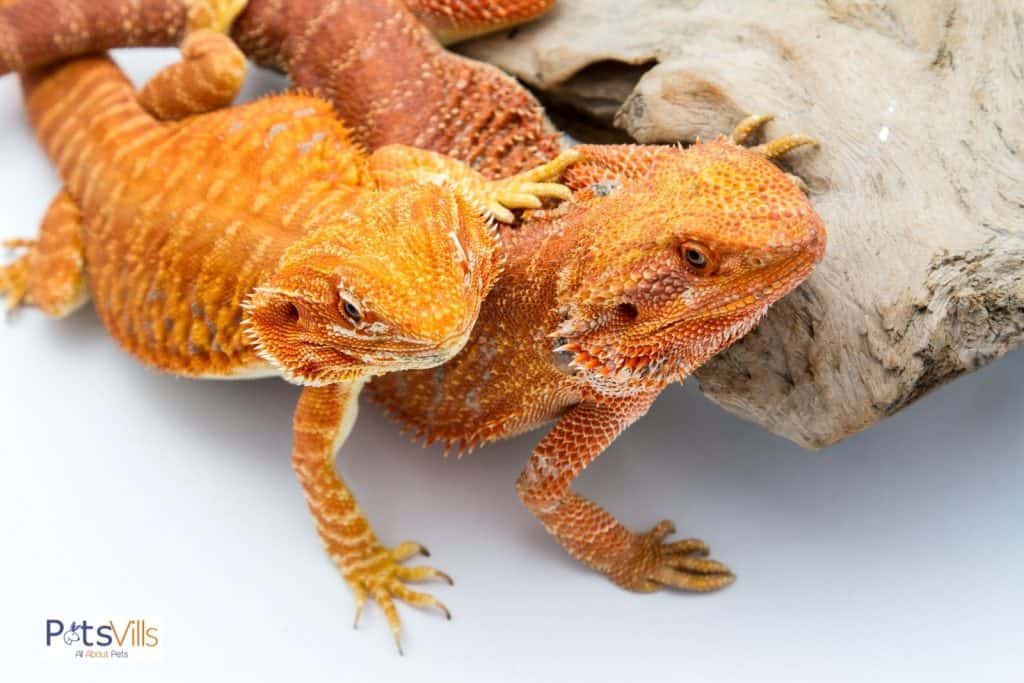
Like most reptiles and birds, bearded dragons (pogona vitticeps) [1] can get pregnant with or without a male.
However, the eggs laid without a male will be infertile.
Let’s briefly review some reproductive aspects of female dragons to understand what happens.
At What Age Do Bearded Dragons Lay Eggs?
Female dragons (pogona vitticeps) reach sexual maturity when they’re between 1 to 2 years old, and this is when they’re ready to lay eggs.
A dragon’s sexual maturity can be recognized by its size.
However, since captivity-raised dragons have access to better food, health, and living conditions, some become sexually mature from as early as ten months of age.
You should also check their weight. Don’t let your beardies mate unless they are at least 400 grams.
On the other hand, male dragons reach sexual maturity when they’re between 80mm for wild dragons and 135.5 mm in size for captivity-raised dragons.
CHECK: Why is My Bearded Dragons Mouth Open?
When is the Breeding Season for Bearded Dragons?
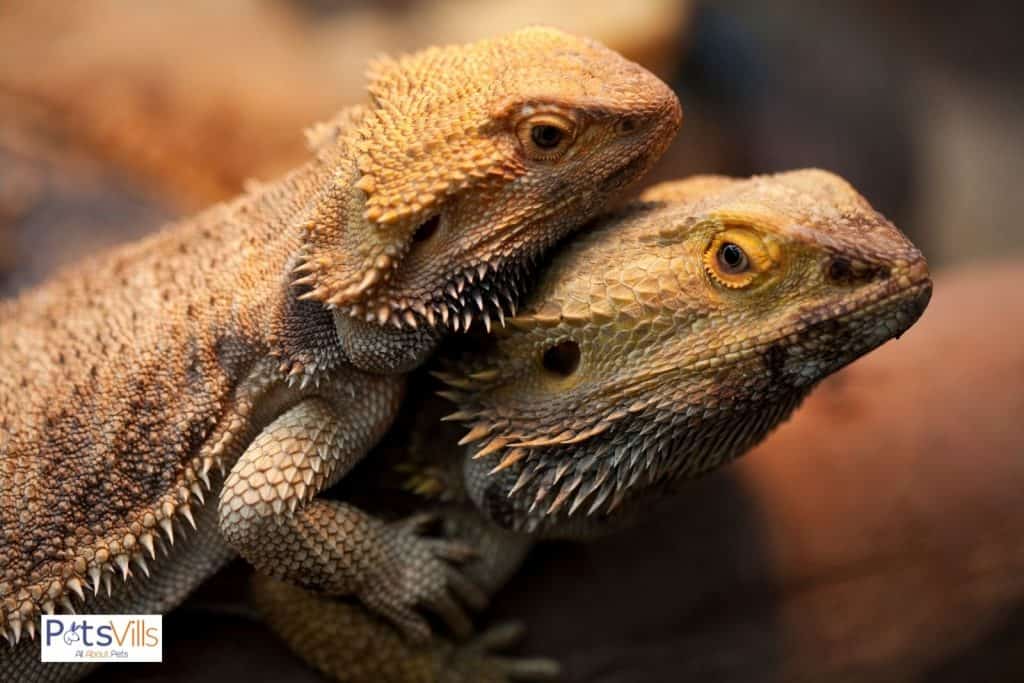
While in the wild, beardies (pogona vitticeps) breed in the warmer seasons (spring and summer).
These months are usually between September and February.
However, the temperatures for captivity-raised beardies are highly regulated to make it possible for them to breed throughout the year. Despite this, they only mate after a process called brumation [2].
Brumation refers to when beardies become inactive and barely eat for some time.
When in the wild, brumation will kick in during colder months, but for dragons in captivity, you’ll have to trigger brumation manually since it’s possible to control the temperature.
You can trigger brumation manually by lowering the temperatures in their tanks to about 75 degrees F to simulate a colder temperature.
After a successful brumation cycle, you can introduce the male and female dragons, and allow them to stay together as you wait for mating.
Mating
Beardies only need to mate with one male during the whole breeding season. That’s because they store the sperms in their oviductal crypts.
When it’s time to mate, the male dragon’s beard blackens, and they nod their heads while circling the female dragon.
The female dragon will acknowledge this and wave its hands while nodding back to show that it wants to mate.
The male dragon climbs on the female dragon’s back. To secure her for the mating process, he bites the neck, holds her back with one of his arms, and secures the area around the tail with his hind legs.
He then inserts one or both of the hemipenes into her cloaca. The process only takes a few minutes.
When it’s over, the female will raise her head and struggle to get away. Sometimes the mating process can get aggressive, but this is normal. Just ensure sure they don’t hurt each other.
Below is a video that shows how all this happens;
You can let both the male and female dragons live in the same tank until you see signs of pregnancy (more on this later).
Why Bearded Dragons Lay Infertile Eggs?
As mentioned earlier, the mating process doesn’t have to occur for pregnancy. Some theories try to explain this.
One theory states [3] that if you have a male and female dragon living near each other, the male may trigger the female’s urge to reproduce, even without mating.
Some owners wonder how often beardies can lay infertile eggs. There’s no exact number, but you can expect 2 to 5 clutches of infertile eggs in every breeding season.
When laying infertile eggs, female dragons will often lay one infertile clutch, which is different from when they lay fertilized eggs as they can lay more clutches of eggs.
RELATED: How to tell if bearded dragon eggs are dead
How to Tell if a Bearded Dragon is Pregnant
You can tell if a female dragon is pregnant by checking her belly and observing changes in behavior.
Below are the most common signs:
1- Pregnant Bearded Dragon Belly
Pregnant dragons appear larger because of the eggs developing inside them. Also, if you feel the pregnant dragon’s belly, you’ll feel some marble-like structures.
2- Feeding
You’ll also note they eat more than they did before. However, female dragons will also be picky with what they want to eat.
That’s because they need nutrients like calcium more when they are pregnant, and not all foods are rich in calcium.
4- Discomfort and Minimal Activity
Pregnant female dragons may appear lazy, and they’ll also experience discomfort, especially when they are about to lay their eggs.
But during the pregnancy, they’ll be calm and spend most of the time lying close to a heat lamp or heat lights.
5- Digging
Female beardies need a suitable place to lay their eggs. That’s why when it’s time, they’ll start digging holes and tunnels on any soft ground they find.
If they don’t find the right place, they will not lay the eggs and may become egg-bound. I will describe how you can build a suitable place later in the article.
Watch this informational video:
Pregnant Bearded Dragon: How Long Does it take to Lay Eggs?
After mating, it takes 4-6 weeks for the dragon to lay the eggs. It can take a few hours to lay all of the eggs, so give your dragon time.
Beardies lay eggs in clutches, and each clutch of eggs can have at least 20 eggs. In total, a dragon can lay up to 90 eggs in one season.
ALSO CHECK: How to Tell if Bearded Dragon is Overweight
How to Care for a Pregnant Bearded Dragon
Once you know your dragon can lay eggs, or realize she is about to lay eggs, there are some steps to take to make sure the dragon and the eggs are safe.
These include:
Step 1: Proper Diet

Pregnant females need a diet rich in calcium. Like other reptiles or birds, calcium plays a significant role in egg formation and the hardening of the shell, and the eggs draw calcium from the dragon’s body.
If the bearded dragon eggs draw more calcium than you’re providing in the diet, it can lead to a calcium deficiency.
This can then cause Metabolic Bone Disease, one of the leading causes of death in beardies [4]. Weak teeth and bones are also a result of calcium deficiency.
On the other hand, the shells will not be hardened if the calcium levels are too low to facilitate egg formation.
This makes it difficult for the eggs to leave the dragon’s body, causing egg binding [5], also known as dystocia (more on this later).
Furthermore, the eggs that manage to leave the body may hurt the beardies’ internal organs, causing infections.
The good news is that meeting the additional calcium requirement isn’t difficult. They can get it from foods like dandelion leaves, collard green leaves, kale, and turnip greens.
You can also get calcium supplementation and sprinkle some into their food.
Step 2: Exercise
Besides proper food, make sure your beardy gets enough exercise. This strengthens their muscles, making it easier for them to lay eggs.
Step 3: Living Conditions
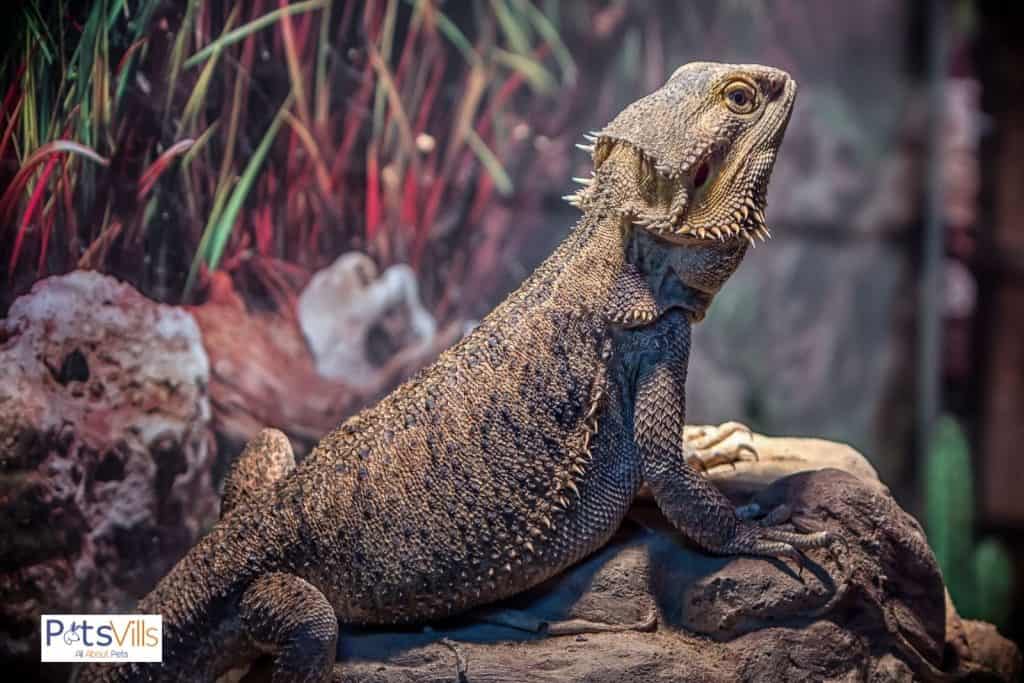
You should also make sure the vivarium’s humidity and temperatures are regulated. When beardies get too hot or too cold, it affects their overall health and can also cause egg binding.
Step 4: Prepare a Lay Box
As mentioned earlier, you need to make sure your pet reptiles have a suitable place to lay their bearded dragon eggs. And you can make it easier for them by preparing a lay box.
Just look for an 8-gallon container with a lid, fill it up to 7 or 8 inches with damp sand or vermiculite and place it in the tank.
You can also create a separate section in the tank where they can go and lay their eggs.
How to Deal With Egg Binding
In some cases, if the pregnancy goes on for too long, it can result in egg binding. As mentioned, poor food and a lack of a suitable place to lay their eggs will cause egg binding.
Some symptoms of egg binding include:
- Lethargy
- Trouble moving
- Swollen cloaca
At this point, you should call your Vet as soon as possible. They can administer hormone shots to make it easier for your dragons to lay their eggs, but severe cases may require surgery.
If you want to know more about egg binding, watch this video:
What to Do With the Bearded Dragon After Laying Eggs?
After laying eggs, beardies will seem smaller since they lose at least 25% of the weight they had. They’ll also be exhausted. The best thing you can do is rehydrate them, offer them food, and let them rest.
How Long Does it Take for Bearded Dragons to Hatch?
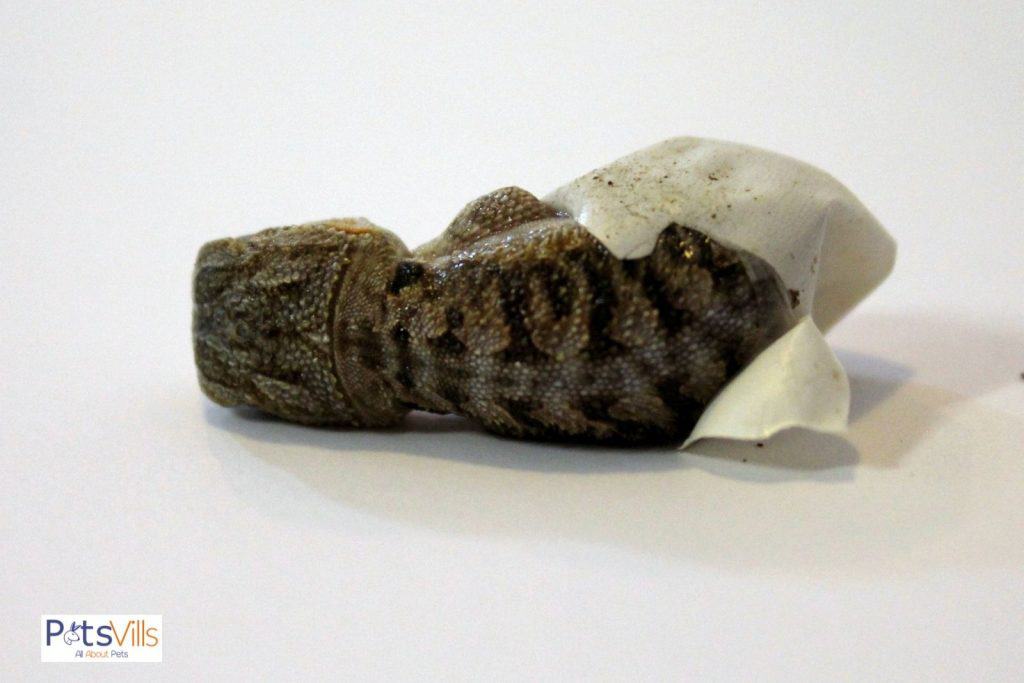
Dragon eggs take 55 to 80 days to hatch. However, it can take up to 90 days in rare cases, especially when temperatures drop below the required levels.
If you want the embryos and baby dragons to be healthy and have a smooth hatching process, you should maintain temperatures of at least 80 to 85 degrees F, and a humidity level not less than that of 75%.
FAQs
How Long Does It Take Bearded Dragons To Lay Eggs?
It takes 4-6 weeks from mating for beardies to lay eggs.
What Do I Do With My Pregnant Bearded Dragon?

Once you realize your beardy is pregnant, you need to start changing their diet. This includes increasing the quantity of food and ensuring your beardie gets extra calcium.
Ensure they get enough physical activity by maintaining the right temperature and humidity levels, and preparing a laying box.
Do Bearded Dragons Stay With Their Eggs?
No, they don’t. They may stay with them for a few hours or a few days at most, but they’ll then move on to lay more eggs.
Conclusion
If you want to get into dragon breeding, I hope this article answers some of your questions. To summarise, beardies will stay pregnant for 4 to 6 weeks, and the eggs will take between 2 to 3 months to hatch.
When pregnant, you can take care of them by providing nutritious food, exercise, ideal living conditions, and making sure they have a suitable place to lay the eggs.
If all goes well, you should be able to produce healthy bearded dragon eggs every season.
References
- 1. Raiti P. Husbandry, Diseases, and Veterinary Care of the Bearded Dragon (Pogona vitticeps). Journal of Herpetological Medicine and Surgery [Internet]. 2012 [cited 2021 Dec 10];22:117. Available from: https://meridian.allenpress.com/jhms/article/22/3-4/117/137217/Husbandry-Diseases-and-Veterinary-Care-of-the
- 2. England J. Bearded Dragon Brumation – Everything You Need To Know (GUIDE) [Internet]. Reptile Advisor. 2019 [cited 2021 Dec 10]. Available from: https://www.reptileadvisor.com/bearded-dragon-brumation/
- 3. KRUZER A. What to Do If Your Bearded Dragon Lays Eggs [Internet]. The Spruce Pets. 2021. Available from: https://www.thesprucepets.com/bearded-dragon-eggs-4171698
- 4. Bearded Dragons – Diseases [Internet]. vca_corporate. 2021 [cited 2021 Dec 10]. Available from: https://vcahospitals.com/know-your-pet/bearded-dragons-diseases
- 5. PetMD Editorial. Egg Binding in Reptiles [Internet]. Petmd.com. PetMD; 2008 [cited 2021 Dec 10]. Available from: https://www.petmd.com/reptile/conditions/reproductive/c_rp_dystocia

Do you have more tips on how to take care of a pregnant bearded dragon? Let us know in the comments below!
Barry Stingmore is a British content writer living in Fuerteventura, Spain. An animal lover at heart, he shares his home with a dog and four rescue cats and has a passion for writing about animals big and small.
Barry loves finding answers to your animal-related questions, the more research involved the better! You can rely on him to find the facts.
Find him on FACEBOOK, TWITTER AND Linkedin
Read his latest ARTICLES.
Find more about him HERE.

